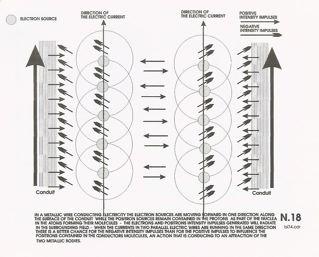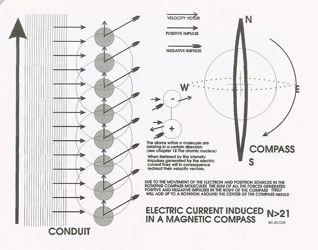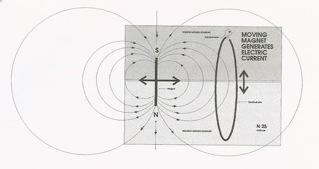Interpretation of electromagnetic phenomena
(Sketches N 19,20,21,22,23,24,25)
The Greek philosophers again were the first in recognizing
and describing the electric and magnetic phenomena. Thales of Miletus made the observation that if amber was energetically
rubbed it would acquire the property of attracting certain light substances demonstrating its ability of acting over another
object without actually touching it.
Thales
had also described the properties of a particular rock found in the neighborly town of Magnesia which also possessed a natural
power of attraction on distant objects. In that case though the power of attraction was limited to certain particu1ar metallic
ores. From the word Electron that the Greeks gave to amber we derived the name Electron and electricity and from the town
of Magnesia, where that particular ore was found the word magnetism. In more recent times other types of materials were discovered
possessing physical properties similar to amber. Substances like glass, resin, rubber and others when stroked could also act
on each other from a distance, but depending on the substance used two opposite reactions could be observed, one exhibiting
attraction and the other repulsion. The observation was also made that two electrified bodies of the same kind would repel
each other while those with opposite charge would attract. This phenomenon was asking for the existence in nature of two kinds
of fluid permeating certain materials that could be energized by rubbing, one producing attraction while the other repulsion.
Benjamin Franklin, one of the first to study the subject, described and named one kind of the electrical fluid positive and
the other negative, speculating that the phenomena observed were caused by a temporary increase or decrease of one of the
fluids permeating the substance of matter. The study of electricity and the experiments devised to evaluate the intensity
and direction of the charges became known as the science of static electricity. During the Renaissance through the effort
of Luigi Galvani and Alessandro Volta an experimental instrument called the Voltaic pile was devised. Wjth this device a continuous
electric current could be made to flow through a metallic wire. Michael Faraday and the French scientist Ampere experimenting
with electric currents found that the same property of attraction and repulsion that characterized static electricity and
natural magnets could be found in an electrical current. If electric currents are progressing along two parallel wires, the
metal conductors are attracting each other when the directions of the flows are the same, if the conditions are reversed an
opposite reaction of repulsion will occur. Those forces producing attraction or repulsion were called magnetic forces. Since
the electric currents exhibited the same phenomena as static electricity and magnetism, they must be part of a common entity.
A greater understanding of the electric phenomena came in 1927 with the discovery of the electron by George
Thompson.
He discovered that a particle
that was part of the atom could under particular circumstances be responsible for the electric phenomena observed. This particle
was found to carry a negative electrical charge and was called the Electron. Since the atom as a whole
was found to be neutral, in order to balance the action of the negative electrons had to carry also positive charges. The
first atomic model conceived by Thompson was described as a positive mass with negative Electrons inserted into it. Rutherford
proposed a new model that envisioned an atom composed of a massive nucleus containing positive charges surrounded by small
negative electrons orbiting at a great distance from it. Since similar electrical charges are repelling each other while opposite
charges are causing attraction, all the phenomena encountered in electricity and magnetism can be attributed to the action
exercised on each other by charged particles. In analyzing these phenomena within the particle physics theory no rational
explanation can be conceived in order to explain how these interactions could occur through what had to be considered to be
empty space.
How ,as experimentally determined
by Faraday,electrical currents could generate forces acting on each other not in a direct way as required by the laws of mechanics
but with angular deviation from the direction of their flow? Faraday advanced the idea of a field as a transmitting medium
that the electromagnetic forces were able to distort when acting on it.
The physicist James Clerk Maxwell followed with a mathematical interpretation that was giving justification to the
belief of the existence of a natural field and opened the door for the science of electromagnetic. The early twentieth century
quantum theory did not alow the existence of a substantial field, therefore, all these attracting and repelling actions exercised
between distant particles could only be explained by an exchange of so called virtual particles, a proposition difficult to
accept rationally. If we accept instead the hypothesis that the universal substance resides within the whole Field and not
in each particle, a new understanding becomes possible. The idea of actions exercised on each other by the particles by means
of waves generated through the Field can now be understood within a classical three-dimensional space. If we perceive the
Electron and the Positron as localized sources of energy producing waves of intensity and implosion in the substance of the
Field, we can envision and describe electric currents and magnetic phenomena with the classical three cardinal axises and
a dimension in time. We can envision an Electron whose dynamic is creating intensity impulses in a plane perpendicular to
the direction of its transitional movement. This fact can explain why a flow of Electrons in an electrical current will exercise
forces acting perpendicularly to that flow. A free Electron source part of a current generated by a potential difference in
a conductor is subjected to the influence of billions of intensity impulses from other participant sources affecting the speed
and direction of their velocity vectors. As a cumulative action each Electron must set his course in a direction parallel
to the conductor advancing from a higher to lower potential. The intensity impulses generated by a Positron confined within
the orbits of a proton source and the movements of the molecule deep inside the conductor, ( when free from the influence
of dislodged electrons) are emitted at an average angular direction of 90 degrees from the direction of the current flowing
into the wire. A similar event will occur with the intensity impulses emitted from the Electrons, in this case though the
sources possess a high velocity along the wire therefore the direction of their trajectories must be at a smaller angle with
the conductor electrical flow. (See figure 19 and 20) When a current is generated in a conductor through a battery or generator
a flow of Electrons will move along it, repelled from the negative pole and attracted by the positive pole magnetic forces
while the positron free from the dislodged Electron influence remains as part of a Proton in the domain of the metallic molecule.
The energy received by two metallic wires from the incoming intensity impulses felt by the positron within the molecule will
tend to move the metal conductor one way or the other according to the cumulative action and type of impulses received. The
movements observed in electrified or magnetized metallic bodies is due therefore to the forces exercised by eEectron and Positron
intensity impulses acting on each other within their molecules. The experiment made by Ampere showed that two close wires
will attract each other if the electrical current in them has the same directional flow, they will repel each other if the
current circulating in them run in opposite ways. In the case of the two wires with the electricity running in the same direction,
the negative intensity impulses released by the Electron on a trajectory angular to the wire have a better chance of entering
and energize the molecules of the conductor than the positive intensity impulses emitted by the Positron with trajectories
closer to 90 degrees to the direction of flow; the result being an attraction. The opposite is true if the electrical currents
are running against each other. (See drawings).
Magnetism
In a now famous experiment conducted in 1818 by Hans Christian Oerstead, a wire was set in a direction parallel to
a compass in its normal North South direction. When an electric current was generated in it, he observed that as soon as the
electricity was turned on the compass would instantly change position from a direction pointing North South to a 90-degree
East West With this experiment electricity and magnetism were confirmed to be two different aspects of the same phenomenon.
It is possible to interpret the electromagnetic phenomena within the scope of the new hypothesis. Every physical event can
be considered as an energy originated motion of the particles composing the field substance within a space-time continuum.
A natural magnet can be considered to be an object in which the molecules forming its body are organized in a particular way.
The Electrons circulating from one pole to the other of the molecules are generating an electrical current possessing an excess
of negative sources on one end and an excess of positive on the other. Each molecule will than be bipolar, therefore in itself
is a magnet. A natural magnet (as it is shown in an experiment with small iron filing) is acting in the surrounding
field by endowing the molecules of the metallic bodies in its vicinity with similar magnetic polarization. In a new understanding
of what is constituting the substance of matter, we can now visualize electricity as a flow of electron sources, while the
magnetic forces manifest themselves through the positive or negative action of the positron and electron sources generated
in a plane perpendicular to the direction of their velocity vector. A magnetized needle is pointing in its natural North
South direction due to the action of the positive and negative intensity impulses emanated by the earth circulating magma;
if we align over it a wire conducting electricity running in the same direction is set above the magnetic needle the negative
and positive forces generated will tend to turn it in an East West direction. If the electricity is running in the opposite
direction, the needle realignment must be in the West East direction this way Oerstead experiment can be rationally understood.
The observation was also made that moving magnetic
line of force created by a magnet can generate a current in an adjacent wire, the direction of its flow determinate by the
direction of the movement. In a magnet in motion its magnetic lines of force will cut through a circular wire generating an
electrical current. Dislodged electrons are flowing in the conductor with a direction that depends from the motion of the
magnet relatively to the conductor. This phenomenon can also be visualized by considering the interactions of the positive
and negative intensity impulses interfering through the field from source to source. If a magnet is set close to a metallic
conductor its presence is acting on its molecules organizing them into magnets as it was found experimenting with iron fillings.
When the magnet is moving so will its generated line of force and so will the magnetized metallic molecules of the conductor
resulting in a flow of Electrons. Of course a flux of Electron moving in the same direction constitutes an electric current.
As soon as the movement of the magnetic lines of force ceases the metallic molecules will return to a static magnetic condition
and the electric current will cease to exist.


